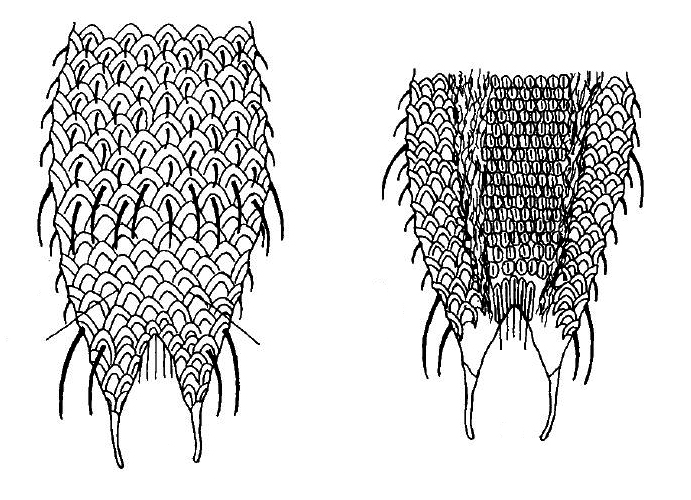Chaetonotus (P. ) acanthodes

124 µm - 159 µm
Width:
35 µm - 40 µm
Width of the head ( weakly five-lobed ):
µm
Length of the furca:
13 µm - 21 µm
Adhessive tubes:
75% of furca
Pharyx ( cylindrical, terminal swollen ):
31 µm - 39 µm
Diameter of the mouth ( round ):
8 µm
Dorsal scales:
10 rows of 20-25 strongly overlapping, rounded triangular scales (5 µm - 8.5 µm) with strongly convex margin (margin appears double) with short spines (7 µm); 7 - 12 simple girdle spines (6.5 µm - 16.5 µm) in alternating rows; scales behind spine girdle mostly without spines
Ventral scales:
4 elongated terminal plates with keel; 8-9 rows of small keel scales
Oecology:
Moor, on mud
Similar species:
well demarcated by spine belt and double scale edge
Particularities:
Spiked belt and double scale edge
Fundorte:
A further representative of the subgenus Primochaetus is the small abdominal hardy Ch. (P.) acanthodes, which is notable for its distinct, spineless scales with a “double” anterior contour and a belt of long spines on the abdomen:
 Ch. acanthodes: dorsal scales
Ch. acanthodes: dorsal scales
Only in the lateral view one recognizes that the spiny belt covers the entire dorsal side of the animal:
 Ch. acanthodes: side view
Ch. acanthodes: side view
The ventral intermediate field is covered with approx. 8 rows of small, roundish keel scales. The rear end is formed by four rectangular, narrow keel plates:
 Ch. acanthodes: ventral scales
Ch. acanthodes: ventral scales
In cross-section, it becomes clear that the scales are strongly curved. This results in the “double contour” in the optical section. The animals I found have one or two teeth at the entrance to the pharynx:
 Ch. acanthodes: Cross-section
Ch. acanthodes: Cross-section